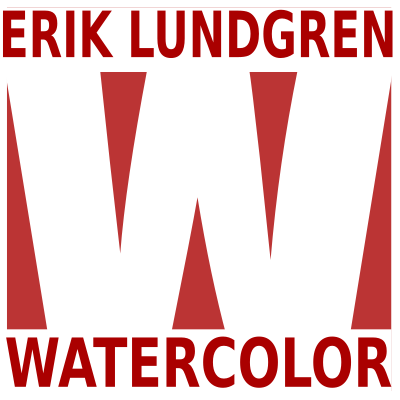Magnesium Ferrite (PBr11)

Magnesium Ferrite is a relatively new pigment, created in 1962, and only a few manufacturers of watercolor paints use it. It is produced through the calcination of a mixture of iron oxide and magnesium oxide.
The color is not staining at all, it is very lightfast, opaque, and exhibits very strong granulation. The hue is somewhat chalky brown-orange, similar to a pale burnt sienna. When freshly applied, it has a slightly yellowish tone, but this fades as it dries, leaving a rather dull orange-brown. Like other granulating colors, Magnesium Ferrite is immobile in water. Do not use this paint for wet-on-wet painting, as it will perform very poorly.
The most distinctive feature of this paint is its ability to form patterns on watercolor paper. It granulates heavily. If you apply a quick wash on the paper, Magnesium Ferrite forms a clear grainy pattern. If you then disturb the paint, add water or more color, various effects occur as the pigment moves, forming streaks and spots.
This is the primary characteristic that makes the color interesting to me. Without this feature, it would be rather flat and unremarkable. There aren’t many colors with such strong granulation. Iron Oxide Black – PBk11 is another example of a watercolor paint with this trait. Another similarity between these colors is their sensitivity to magnetic influence. A magnet under the paper can move the pigments in wet paint.

For me, this is a paint to use well-diluted for effects, in the same way I use Iron Oxide Black. It is not a color for traditional watercolor painting. It can never replace a vibrant burnt sienna; it’s far too dull for that. However, it can be a nice addition when extreme effects are desired. When well-diluted, its negative qualities disappear, highlighting the pleasant side of this pigment, much like with Iron Oxide Black.
There aren’t many suppliers of this color. I’ve only found two major manufacturers, namely Daniel Smith, who calls it “Lunar Earth,” and Roman Szmal, who has named the color “Aquarius Brown.” A handful of smaller manufacturers also offer it, and the pigment can be found in some blended colors as well. Some claim that the color Magnesium Brown from Winsor & Newton, labeled as Zinc Iron Yellow (PY119), is actually Magnesium Ferrite. However, this is something I cannot confirm.



It is worth noting that Daniel Smith labels the color as transparent, which is clearly incorrect. The same applies to the color from Roman Szmal, which all retailers describe as semi-transparent. It can be difficult to rely on manufacturers’ claims.
Color Index: PBr11
Lightfastness: Very good
Transparency: Opaque
Staining: None
Granulation: Extremely high

















